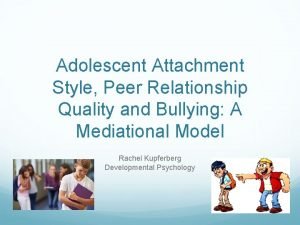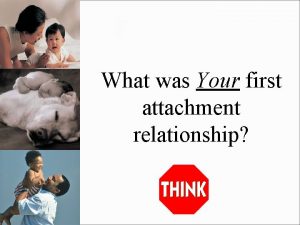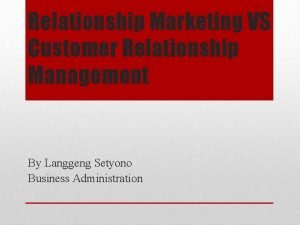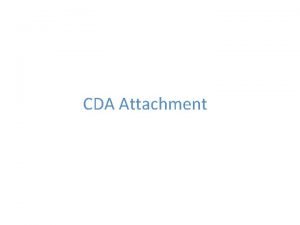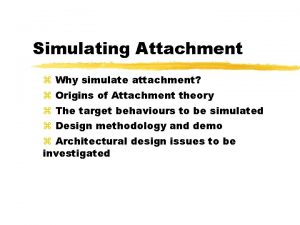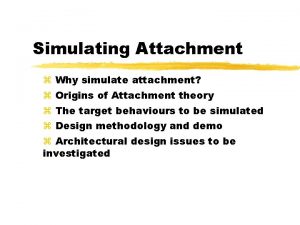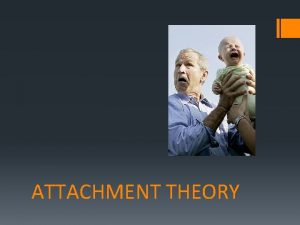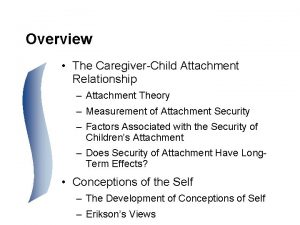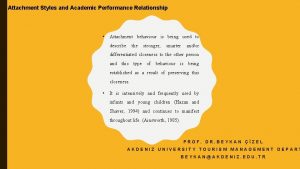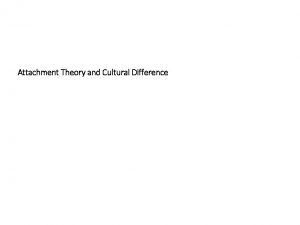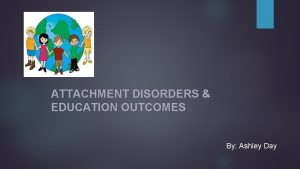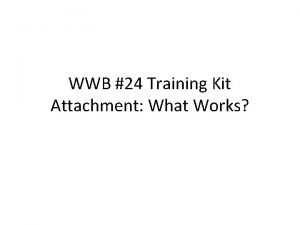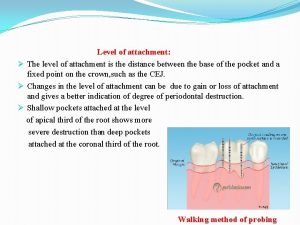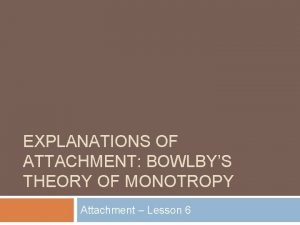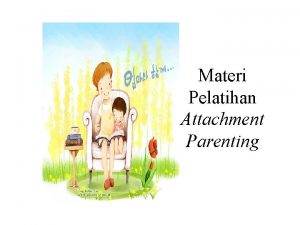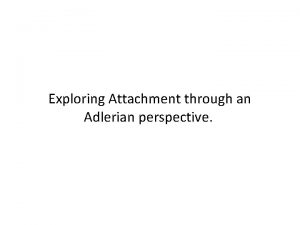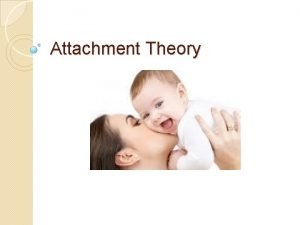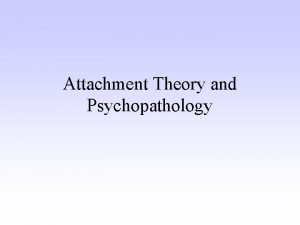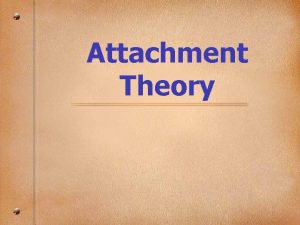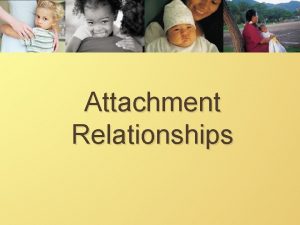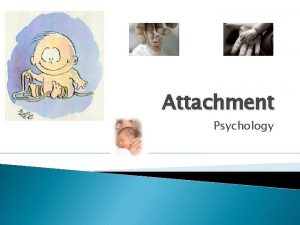What was Your first attachment relationship The first




































- Slides: 36

What was Your first attachment relationship?

The first special relationship we experience develops between parent and child It is believed that this relationship will influence the development of our future relationships

What is Attachment? ‐ Attachment is a strong, longlasting emotional connection ‐A close emotional bond that is “person-specific” and is enduring across time.

Think on your own… How do you know an infant is attached to someone?

Think on your own… How do you know an infant is attached to someone? Infants show their attachment through proximity-seeking behaviors, meaning infants like to be near those we are attached.

Why do infants form attachments? ‐ Bowlby (1977) argued that the infant’s emotional tie with its mother (principal caregiver) evolved because it promotes survival. ‐ Children who form an attachment to an adult develop a deeper parentchild relationship and are more likely to survive. ‐ He also believed that an infant’s early interactions with a parent were crucial to “normal development”

How does love develop between mother and child? Harry Harlow studied the impact of security and “contact comfort” on infant attachment.

Harry Harlow (1959) “The Monkey Love experiments” ‐ Harlow evaluated whether feeding or contact comfort was more important to infant attachment. ‐ ‐ The young animals were “raised” by two kinds of surrogate monkey mother machines. One mother was made of soft terry cloth, the other made of wire mesh

“Monkey Love Experiments” ‐ Harlow's research showed that the need for affection created a stronger bond between mother and infant than did physical needs (food).

Harlow’s work suggested that the development of a child’s love for their caregiver was emotional rather than physiological

What does this mean for humans? ‐ Harlow showed that the development of attachment was closely associated with critical periods in early life. ‐It is difficult or impossible to compensate for the loss of initial emotional security

Further experiments on abusive conditions showed that no matter how abusive the “Iron Maidens” were, the baby monkeys always came back and displayed affection towards them. Even in the face of abuse, the need for love was overwhelming

What happened to these monkeys? ‐ Monkeys raised without their mothers or other monkeys were socially maladjusted the rest of their lives. ‐ When confronted with fear, they displayed autistic and institutionalized behaviors-throwing themselves on the floor, clutched themselves, rocked back and forth, and screamed in terror. ‐ They were incapable of having sexual relations and they were also unable to parent their offspring, either abusing or neglecting them.

"Not even in our most devious dreams could we have designed a surrogate as evil as these real monkey mothers were. "

Did Harlow’s work influence our society? True or false? ‐ Less than 50 years ago parents were told by doctors that rocking or picking up a crying infant could “damage” them.

Did Harlow’s work influence our society? True or false? ‐ Less than 50 years ago parents were told by doctors that rocking or picking up a crying infant could “damage” them.

Did Harlow’s work influence our society? True or false? ‐ Less than 50 years ago parents were told by doctors that rocking or picking up a crying infant could “damage” them. TRUE!

True or False? ‐ Lack of attachment can be made up for later in life by a lot of contact with peers

True or False? ‐ Lack of attachment can be made up for later in life by a lot of contact with peers FALSE!!

True or False? ‐ “Do not overindulge them. Do not kiss them goodnight. Rather, give a brief bow and shake their hand before turning off the light. ”

True or False? ‐ “Do not overindulge them. Do not kiss them goodnight. Rather, give a brief bow and shake their hand before turning off the light. ” FALSE!

It is beneficial to place a newborn directly on its mother's belly after birth

It is beneficial to place a newborn directly on its mother's belly after birth TRUE!

Do we all need attachment and physical contact? ‐ Yes, according theories of John Bowlby (1969, 1991), that children who form an attachment to an adult are more likely to survive. ‐ Attachment not only deepens the parent-child relationship, but may have contributed to human

The Quality of Attachment Based on how the infant reacts to separation from the caregiver and the reunion by using a procedure known as the Strange Situation.

Ainsworth (1993) and others have identified 4 basic types of attachment relationships 1. 2. 3. 4. Secure Attachment Insecure/Resistant Insecure/Avoidant Insecure/Disorganized


Types of Attachment ‐ Secure attachment is a relationship of trust and confidence. ‐ During infancy this relationship provides a secure base for exploration of the environment. ‐ ‐ This group seems to say “I missed you terribly, but now that you’re back, I’m okay. ” 60 -65% of American children have secure attachment relationships (Kail, 2007).

3 Types of Insecure Attachment ‐ Insecure-Avoidant ‐ Infants attachment: or young children seem somewhat indifferent toward their caregivers and may even avoid their caregivers

If they do get upset when left alone, they are as easily comforted by a stranger as by a parent. As if to say, “you left me again, I always have to take care of myself!” 20% of American infant have avoidantattachment

Resistant/ambivalent Attachment ‐ Infants or young children are clingy and stay close to their caregivers rather than exploring their environment. ‐ The baby is upset when the mother leaves and remains upset or even angry when she returns, and is difficult to console

Disorganized attachment ‐ Infants or young children have no consistent way to coping with the stress of the “Strange Situation” ‐ The baby seems confused when the mother leaves and when she returns. ‐ This leads to problems with emotional regulation, social function and severe emotional problems. ‐ Less than 5% of middle-class Americans fall into this category.

Name that Attachment Relationship! ‐A baby in this group might say “I missed you terribly, but now that you’re back, I’m okay. ” ‐A baby in this group might say “You left me again. I always have to take care of myself. ”

‐A Name that Attachment Relationship! baby in this group might say “I missed you terribly, but now that you’re back, I’m okay. ” Secure ‐A baby in this group might say “You left me again. I always have to take care of myself. ” Insecure/Avoidant

‐A Name that Attachment Relationship! baby in this group might say “Why do you do this? I get so angry when you’re like this. ” ‐A baby in this group might say “What’s going on here? I want you to be here, but you left and now you’re back. I don’t know whether to laugh or cry. ”

‐A Name that Attachment Relationship! baby in this group might say “Why do you do this? I get so angry when you’re like this. ” Resistant ‐A baby in this group might say “What’s going on here? I want you to be here, but you left and now you’re back. I don’t know whether to laugh or. Disorganized cry. ”
 Attachment styles in relationships
Attachment styles in relationships First attachment
First attachment Give us your hungry your tired your poor
Give us your hungry your tired your poor Relationship management vs relationship marketing
Relationship management vs relationship marketing Hình ảnh bộ gõ cơ thể búng tay
Hình ảnh bộ gõ cơ thể búng tay Bổ thể
Bổ thể Tỉ lệ cơ thể trẻ em
Tỉ lệ cơ thể trẻ em Gấu đi như thế nào
Gấu đi như thế nào Tư thế worm breton là gì
Tư thế worm breton là gì Hát lên người ơi alleluia
Hát lên người ơi alleluia Các môn thể thao bắt đầu bằng tiếng đua
Các môn thể thao bắt đầu bằng tiếng đua Thế nào là hệ số cao nhất
Thế nào là hệ số cao nhất Các châu lục và đại dương trên thế giới
Các châu lục và đại dương trên thế giới Công của trọng lực
Công của trọng lực Trời xanh đây là của chúng ta thể thơ
Trời xanh đây là của chúng ta thể thơ Mật thư anh em như thể tay chân
Mật thư anh em như thể tay chân 101012 bằng
101012 bằng độ dài liên kết
độ dài liên kết Các châu lục và đại dương trên thế giới
Các châu lục và đại dương trên thế giới Thể thơ truyền thống
Thể thơ truyền thống Quá trình desamine hóa có thể tạo ra
Quá trình desamine hóa có thể tạo ra Một số thể thơ truyền thống
Một số thể thơ truyền thống Cái miệng xinh xinh thế chỉ nói điều hay thôi
Cái miệng xinh xinh thế chỉ nói điều hay thôi Vẽ hình chiếu vuông góc của vật thể sau
Vẽ hình chiếu vuông góc của vật thể sau Thế nào là sự mỏi cơ
Thế nào là sự mỏi cơ đặc điểm cơ thể của người tối cổ
đặc điểm cơ thể của người tối cổ Thứ tự các dấu thăng giáng ở hóa biểu
Thứ tự các dấu thăng giáng ở hóa biểu Vẽ hình chiếu đứng bằng cạnh của vật thể
Vẽ hình chiếu đứng bằng cạnh của vật thể Vẽ hình chiếu vuông góc của vật thể sau
Vẽ hình chiếu vuông góc của vật thể sau Thẻ vin
Thẻ vin đại từ thay thế
đại từ thay thế điện thế nghỉ
điện thế nghỉ Tư thế ngồi viết
Tư thế ngồi viết Diễn thế sinh thái là
Diễn thế sinh thái là Dạng đột biến một nhiễm là
Dạng đột biến một nhiễm là Số nguyên tố là số gì
Số nguyên tố là số gì
